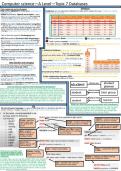Summary
COMPACT SUMMARY FOR TOPIC 7: Databases
- Course
- Institution
Master Database Concepts for A-Level Computer Science! Enhance your revision with our A-Level Computer Science Revision Summary on Databases. This essential guide simplifies complex topics such as relational databases, SQL, and data management techniques. Learn how to efficiently capture, stor...
[Show more]



